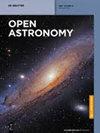The Mg/Fe ratio of silicate minerals in the meteoritic materials and in the circumstellar environment: A case study for the chondritic-like composition
IF 0.5
4区 物理与天体物理
Q4 ASTRONOMY & ASTROPHYSICS
引用次数: 0
Abstract
Abstract Kaba meteorite as a reference material (one of a least metamorphosed and most primitive carbonaceous chondrites fell on Earth) was chosen for this study providing an adequate background for study of the protoplanetary disk or even the crystallization processes of the Early Solar System. Its olivine minerals (forsterite and fayalite) and their Mg/Fe ratio can help us to understand more about the planet formation mechanism and whether or not the metallic constitutes of the disk could be precursors for the type of planets in the Solar System. A multiple methodological approach such as a combination of the scanning electron microscope, optical microscope, Raman spectroscopy and electron microprobe of the olivine grains give the Fe/Mg ratio database. The analyses above confirmed that planet formation in the protoplanetary disk is driven by the mineralogical precursors of the crystallization process. On the other hand, four nebulae mentioned in this study provide the astronomical data confirming that the planet formation in the protoplanetary disk is dominated or even driven by the metallic constituents.陨石材料和星周环境中硅酸盐矿物的Mg/Fe比:以球粒陨石类成分为例
本文选择卡巴陨石作为参考材料(地球上变质最少、最原始的碳质球粒陨石之一)进行研究,为研究早期太阳系的原行星盘甚至结晶过程提供了充分的背景。它的橄榄石矿物(橄榄石和橄榄石)和它们的镁铁比可以帮助我们更多地了解行星的形成机制,以及盘的金属成分是否可能是太阳系行星类型的前兆。采用扫描电子显微镜、光学显微镜、拉曼光谱和电子探针等多种方法,建立了橄榄石颗粒的铁/镁比数据库。上述分析证实了原行星盘中行星的形成是由结晶过程的矿物学前体驱动的。另一方面,本研究中提到的四个星云提供了天文数据,证实了原行星盘中的行星形成是由金属成分主导甚至驱动的。
本文章由计算机程序翻译,如有差异,请以英文原文为准。
求助全文
约1分钟内获得全文
求助全文
来源期刊

Open Astronomy
Physics and Astronomy-Astronomy and Astrophysics
CiteScore
1.30
自引率
14.30%
发文量
37
审稿时长
16 weeks
期刊介绍:
The journal disseminates research in both observational and theoretical astronomy, astrophysics, solar physics, cosmology, galactic and extragalactic astronomy, high energy particles physics, planetary science, space science and astronomy-related astrobiology, presenting as well the surveys dedicated to astronomical history and education.
 求助内容:
求助内容: 应助结果提醒方式:
应助结果提醒方式:


